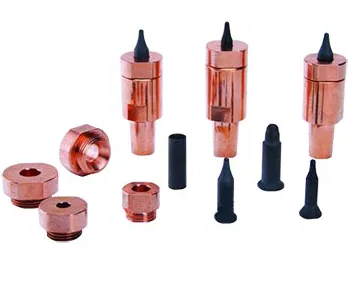Projection nut welding is done every day in sheet metal fabrication shops. In most, tooling is used to locate the nut on the part. A centering pin is frequently part of this tooling.

AUTOMATED NUT FEED TOOLING COMPONENTS
These pins function as a locator and in most cases also have to be an electrical insulator to prevent current flow through the pin and damage to the threads of the nut. To prevent this the locator pin is electrically insulated by some means.
The question posed above is: What material is best for nut welding? This applications demands good wear, long life and insulation. Options in the marketplace are:
Solid Ceramic pins
Metallic Pins (insulated by an insulating sleeve or coating in the holder)
Ceramic coated metallic pins
All three are being used. They all work. They all have pros and cons.
In automated systems the pin will see impact abuse as the parts are loaded. Each time the nut loads friction can cause wear on the ceramic surface or coating. Flash can cause the pins to stick and not retrack, increasing the abuse. The pins take a lot of abuse and see a lot of heat. We have: IMPACT, FRICTION, FLASH and HEAT. These problems lead to nut misfeeds or thread arcing and damage.
Which of these issues is present?
Which pin design is the best to solve that issue?
Is it cost effective?
Is it available in the quantity needed?
A material with a yes to all of these questions is the best material for the application.
A local distributor or supplier will be able to help in the evaluation of the best option for the application.
Reference: RWMA – Resistance Welding Manual 4th Edition

